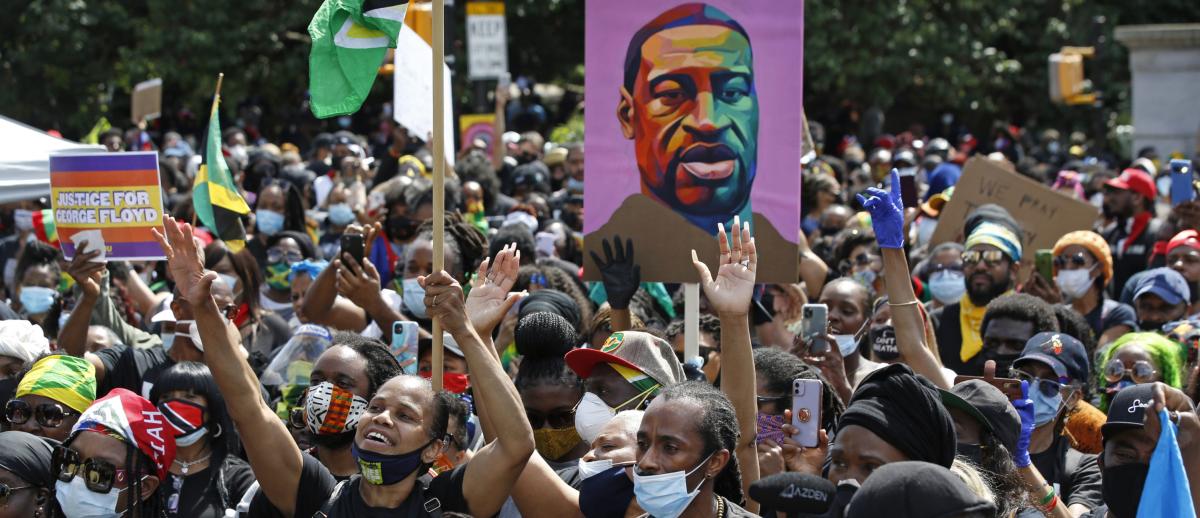Civil Society and Peaceful Social Change: Black Lives Matter
archive


A Caribbean-led Black Lives Matter rally at Brooklyn's Grand Army Plaza on June 14, 2020 (Photo: Kathy Willens/AP)
Civil Society and Peaceful Social Change: Black Lives Matter
We may be on the verge of a violent civil conflict in the US. The extent of polarization and protest are similar to that seen in countries which have transitioned from peacefulness to violent civil conflict. Arab uprisings in Middle Eastern countries emerged as mass protests after 2011 in response to the unresolved long-lasting grievances in these societies. The protests caused an overall deterioration in the peacefulness of this region by pushing several of these countries—Egypt, Yemen, and Syria—into violent civil conflict. Even Europe, one of the most peaceful regions of the world, has seen an upward trend in polarization and decrease in peacefulness in recent years, most notably Spain and Turkey.1 Even though not violent, increased polarization and conflict has also been on the rise in the UK and France due to Brexit and the yellow vest movement.
Particularly notable in the US context are the reactions of some politicians, most evidently the president, to the Black Lives Matter (BLM) movement and protests. While the country suffers the consequences of decades-long race-based discrimination and structural inequalities, counter-responses from some of the Republican leadership and Donald Trump further escalated the conflict. Trump’s June 20, 2020 speech in Tulsa, Oklahoma evoked memories of the worst racial discrimination in the history of the country. Even more opprobrious were the June 16 remarks made by Larry Pittman, a Republican Congressman from North Carolina, who posted on Facebook that we need to ensure that the police are fully armed and permitted to shoot protesters on sight.2 These are examples of statements that were widely covered by the media. There is little doubt that they are also echoed in varying degrees by both Trump supporters and the silent majority, a term coined during the Nixon years to refer to a groundswell of quiet support garnered for Republicans primarily from the Midwestern states.
With the prospect of further escalation on the near horizon, leading up to and following the November election, we are encouraged to address questions about the role of civil society or citizens in fomenting outrage and accomplishing the social changes needed for a more just and inclusive society. Faced with a strong demand for social change, civil society can play a critical role both by participating in peaceful non-violent action and in facilitating dialogue between the contending actors, for example, the two major US political parties.
Two Phases of Social Movements
We regard these two types of activities as early and late phases in the life of social movements bent on achieving social change.3 By fomenting we refer to capturing widespread sentiments about an issue by mobilizing citizens to protest the way that their fellow citizens have been treated by the government and other societal institutions. The protests in the US are generally unorganized in the sense of leadership and organizational structure. By accomplishing, we refer to a more structured process of negotiation and a somewhat less structured process of dialogue to coalesce the protesters’ collective sentiments into reforms leading to legislation that addresses the historical injustices. The key point is that both processes need to go hand in hand if long-lasting change is to emanate.4 Peaceful mobilization of citizens around collective sentiments motivates masses and political elites to take collective action in order to find remedies to the situation. However, this should be followed by an inclusive dialogue and negotiation process between various actors so that the motivation can turn into concrete accomplishments in policy and practice.
Fomenting change
The BLM movement is currently in the fomenting stage. The police killing of George Floyd was the spark that unleashed pent up feelings of outrage about racial injustice in the US and in many other countries around the world. The early spontaneous protests were contagious. They were followed in the US Congress by police reform legislation in alternative versions by the political parties. The more sweeping reforms were put forth by the Democrats. These legislative activities are regarded as the organized phase of a social movement. Should the parties reach agreement on a bi-partisan bill, that legislation could be a turning point in the path from trigger (George Floyd death) to precipitant (mobilized protests) to departure (reform legislation). Whether the path has consequences for lasting social change remains to be seen.
The BLM protests express a collective sense of outrage. Their success to date may be understood in terms of the size and representativeness of the events and by unity among the protesters. These factors have been shown to affect the way that political representatives weigh the salience of the issues, the positions they take, and their intended actions.5 The success is also due to the dramatic shifts in public opinion, influenced as well by media coverage, favoring the movement and its purpose among most demographic categories during the past few weeks.6 The evident impacts illuminate the importance of civil society during the fomenting phase of social movements. The impacts also show that successful peaceful protests pave the way for accomplishing social change. We have seen examples of this in other places such as Nepal and Tunisia, where a demand for social change began with widespread protests and evolved successfully into a negotiated agreement leading to political reforms and restructuring. In Nepal, the protests that were followed by negotiations between political parties and the Maoists brought the monarchy to an end and made transition into a federal secular state with a new constitution possible.7 In Tunisia, the protests ended the long authoritarian rule and the following negotiations produced agreement among different parts of the society and paved the way to reforms.8 Neither of these processes was smooth; both were characterized by peaks and valleys and still have many challenges. Eventually though they put each of these countries on a trajectory of social change based on democratic consensus toward a more inclusive and just society.
Accomplishing change
The accomplishing phase of a social movement consists of including a broad representation of civil society actors to craft legislative proposals and other policy reforms. Recent comparative research suggests that when civil society is included in negotiation processes, the likelihood of durable peace increases significantly.9 Other activities include facilitation or mediation of dialogue and negotiations, building social cohesion across different parts of the society, as well as peace education and socialization to uncover and deal with the root causes of the problem.10 These activities are aimed at increasing the perceived legitimacy of any negotiated agreement reached by political elites.
The police killing of George Floyd was the spark that unleashed pent up feelings of outrage about racial injustice in the US and in many other countries around the world.
Thania Paffenholz suggests seven modalities for how negotiations can be made more inclusive: direct representation of civil society at the negotiation table (e.g. national dialogues), granting observer status to civil society actors during the negotiations, consultations with civil society actors in public forums or in smaller groups, setting up inclusive commissions, holding problem-solving workshops with representatives from different parties, referendums, and mass action.11 Two of these modalities are highlighted here as being especially useful for the current crisis involving awareness of structural racism, police brutality, and gun violence: national dialogues and inclusive commissions.
The purpose of a national dialogue is to bring together representatives from all parts of the society into a broad and participatory negotiation process. The objective is to resolve political crises emanating from the failure of the existing social contract in order to lead societies in the direction of peaceful political transition based on broad consent. National dialogues are usually convened after political protests that bring to the fore the deep-rooted causes of conflicts.12 A recent successful case is Tunisia, where a national dialogue involving civil society representatives from different ideological and political backgrounds, known as the Quartet, led the country into peaceful transition and broad-based consensus around the constitution and political reforms. Their activity led to a Nobel Peace prize in 2015. The dialogue also served as a transition from a mass movement without national leaders into one that fostered the future leadership engendering change in the country.

In January 2014, Tunesians celebrate the third anniversary of the uprising that ousted longtime dictator Zine El Abidine Ben Ali. (Photo: AFP/Getty)
With regard to the BLM movement, there seems to be a need for a broad-based societal dialogue involving representatives of different ethnic and racial communities, police, lawmakers, political parties, as well as local and national government representatives. This process would focus on reforms needed to address the root causes of the problem. Such an inclusive dialogue, with input from key stakeholders, is likely to be more constructive than legislative proposals or a reform agenda pushed unilaterally by each of the political parties. The dialogue also contributes to developing social cohesion among groups unlikely to talk with one another and establishing the new leaders of a peaceful social transition.
The second relevant modality is inclusive commissions. These are usually set up with a specific purpose or task such as drafting a new constitution or planning specific political reforms.13 They are small units composed of a dozen or so representatives, but they are inclusive in terms of the selection of these representatives, notably those from civil society. In our recent comparative research on civil wars around the world,14 we found that convening inclusive commissions are positively correlated with durable peace. Their existence makes durable peace, both in terms of reconciliation and institutional reform, more likely. An inclusive commission can be given an official mandate to plan the process for police and law enforcement reforms. This commission would also include multi-racial and ethnic representatives of the protest movement. With connections to both the decision-making elite and the grassroots social movements, an inclusive commission can be a key bridge to a reform process by tying all levels of the society together effectively.
Protests: Civil War or Peaceful Social Change?
It took many years of disciplined organizing and outreach for the BLM movement to reach today’s level of effectiveness and impact. The movement is now supported by a wide coalition including but not limited to the African-American community. This by itself is a major accomplishment and increases the likelihood of social change in the desired direction. However, we argue that there is a need for a second leap forward: move this civil society movement into the dialogue and negotiation space to transform the current momentum into durable change. This is not a trivial task. Lessons learned from other conflict settings with regard to civil society inclusion in negotiation processes can be useful in designing similar processes in the US. Examples from our comparative research include Liberia (2003), Papua New Guinea (2001), Sierra Leone (1999), South Africa (1993), and the United Kingdom (1998). In these societies an inclusive commission or a national dialogue process with multiple stakeholders helped to insure a peaceful social transition rather than a one-sided and top-down contentious legislation process.
1. For these trends and others see Global Peace Index 2018 data available at http://visionofhumanity.org/app/uploads/2018/06/Global-Peace-Index-2018-2.pdf
2. Charlotte Observer, June 16, 2020.
3. For a similar distinction see Malcolm Gladwell (2019). Talking to Strangers. New York: Little, Brown and Company.
4. Nadine Bloch and Lisa Schirch. (2019). Synergizing Nonviolent Action and Peacebuilding: An Action Guide. United States Institute of Peace Publications.
5. Ruud Wouters and Stephaan Walgrave. (2017). “Demonstrating power: How protest persuades political representatives.” American Sociological Review 82 (2): 361-383.
6. New York Times, June 10, 2020.
7. Deepak Thapa and Alexander Ramsbotham. (2017) “Two Steps Forward One Step Back: The Nepal Peace Process.” Accord(26) London: Conciliation Resources.
8. Anouar Boukhars. (2015) The Reckoning: Tunisia’s Perilious Path to Democratic Stability. Carnegie Endowment for International Peace. Retrieved from https://carnegieendowment.org/2015/04/02/reckoning-tunisia-s-perilous-path-to-democratic-stability-pub-59571
9. Desiree Nilsson. (2012) “Anchoring the Peace: Civil Society Actors in Peace Accords and Durable Peace.” International Interactions, 38 (2): 243-266; Esra Cuhadar and Thania Paffenholz. (2017) “What’s a Constructive Peace Process? Inclusion inPeace Negotiations.” In Perspectives in Waging Conflicts Constructively: Cases, Concepts, and Practice, B. Dayton and L. Kriesberg (eds.). Boulder, CO: Rowman and Littlefield.
10. For a full list of civil society functions in peacebuilding see Thania Paffenholz (ed.) (2009) Civil Society and Peacebuilding: A Critical Approach. Boulder, CO: Lynne Rienner Publishers.
11. Thania Paffenholz. (2014). “Civil Society and Peace Negotiations: Beyond the Inclusion-Exclusion Dichotomoy.” Negotiation Journal, 30 (1): 69-91.
12. Thania Paffenholz, Anne Zachariassen, and Cindy Helfer. (2017). What Makes or Breaks National Dialogues? Geneva: Inclusive Peace & Transition Initiative (The Graduate Institute of International and Development Studies).
13. Paffenholz (2014); Cuhadar and Paffenholz (2017) for additional information on inclusive commissions.
14. The analyses on the role of civil societies in creating durable peace is an extension of our research on terminating civil wars. See Daniel Druckman and Lynn Wagner (2019). “Justice Matters: Peace Negotiations, Stable Agreements, and Durable Peace.” Journal of Conflict Resolution 63 (2): 287-316.




